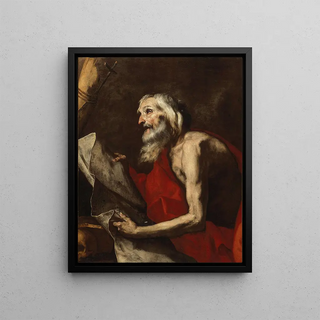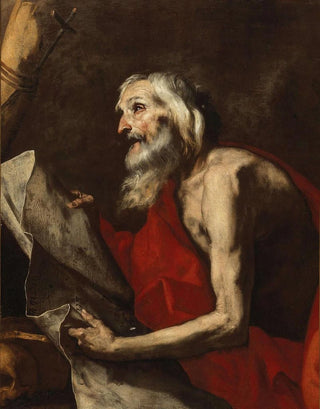Art print | Saint Jerome - Jusepe de Ribera


View from behind

Frame (optional)
In the fascinating world of baroque art, the "Saint Jerome" art print by Jusepe de Ribera stands out as an iconic masterpiece. This painting, depicting the saint in a moment of deep meditation, invites the viewer to immerse themselves in an atmosphere of reflection and spirituality. The power of the composition and the intensity of the emotions conveyed by Jerome's face captivate instantly. The light, skillfully manipulated, illuminates the saint's face, highlighting the gravity of his mission and the depth of his soul. Through this work, Ribera manages to transcend a simple portrait to offer a true exploration of the human condition.
Style and uniqueness of the work
Jusepe de Ribera's style is characterized by a realistic approach and meticulous attention to detail. In "Saint Jerome," every fold of the robe, every nuance of light on the skin, demonstrates exceptional craftsmanship. The artist skillfully plays with contrasts between shadows and lights, a technique that enhances the expressiveness of the saint's face. He is depicted with great humanity, far from the idealized representations often seen in religious art. Ribera chooses to show Jerome in his vulnerability, capturing a moment of introspection. The color palette, dominated by warm and earthy tones, creates an atmosphere that is both intimate and dramatic, inviting the viewer to feel the depth of spirituality emanating from the work.
The artist and his influence
Jusepe de Ribera, born in Spain but having spent much of his life in Italy, embodies the bridge between Spanish tradition and Italian Renaissance. His work is marked by Caravaggisti influence, but he develops a style that is uniquely his own, combining realism and raw emotion. Ribera captured the attention of his contemporaries with his poignant depictions of saints and martyrs, and "Saint Jerome" is a perfect example. His work not only influenced his peers but also left a lasting imprint on baroque painting. Later artists often sought to imitate his mastery of light and

Matte finish

View from behind

Frame (optional)
In the fascinating world of baroque art, the "Saint Jerome" art print by Jusepe de Ribera stands out as an iconic masterpiece. This painting, depicting the saint in a moment of deep meditation, invites the viewer to immerse themselves in an atmosphere of reflection and spirituality. The power of the composition and the intensity of the emotions conveyed by Jerome's face captivate instantly. The light, skillfully manipulated, illuminates the saint's face, highlighting the gravity of his mission and the depth of his soul. Through this work, Ribera manages to transcend a simple portrait to offer a true exploration of the human condition.
Style and uniqueness of the work
Jusepe de Ribera's style is characterized by a realistic approach and meticulous attention to detail. In "Saint Jerome," every fold of the robe, every nuance of light on the skin, demonstrates exceptional craftsmanship. The artist skillfully plays with contrasts between shadows and lights, a technique that enhances the expressiveness of the saint's face. He is depicted with great humanity, far from the idealized representations often seen in religious art. Ribera chooses to show Jerome in his vulnerability, capturing a moment of introspection. The color palette, dominated by warm and earthy tones, creates an atmosphere that is both intimate and dramatic, inviting the viewer to feel the depth of spirituality emanating from the work.
The artist and his influence
Jusepe de Ribera, born in Spain but having spent much of his life in Italy, embodies the bridge between Spanish tradition and Italian Renaissance. His work is marked by Caravaggisti influence, but he develops a style that is uniquely his own, combining realism and raw emotion. Ribera captured the attention of his contemporaries with his poignant depictions of saints and martyrs, and "Saint Jerome" is a perfect example. His work not only influenced his peers but also left a lasting imprint on baroque painting. Later artists often sought to imitate his mastery of light and






